England
England | |
|---|---|
| Motto: [Dieu et mon droit] Error: {{Lang}}: text has italic markup (help) (French) "God and my right"[1][2] | |
| Anthem: None (de jure) Jerusalem, Land of Hope and Glory (de facto) | |
 | |
| Capital and largest city | London |
| Official languages | English1 |
| Recognised regional languages | Cornish |
| Ethnic groups | 90% White, 5.3% South Asian, 2.7% Black, 1.6% Mixed race, 0.7% Chinese, 0.6% Other |
| Demonym(s) | English |
| Government | Constitutional monarchy |
• Monarch | Queen Elizabeth II |
| Gordon Brown MP | |
| Legislature | Parliament of the United Kingdom |
| Area | |
• Total | 130,395 km2 (50,346 sq mi) |
| Population | |
• 2008 estimate | 51,446,0003 |
• 2001 census | 49,138,831 |
• Density | 395/km2 (1,023.0/sq mi) |
| GDP (PPP) | 2006 estimate |
• Total | $1.9 trillion |
• Per capita | US$38,000 |
| GDP (nominal) | 2006 estimate |
• Total | $2.2 trillion |
• Per capita | $44,000 |
| HDI (2006) | Error: Invalid HDI value |
| Currency | Pound sterling (GBP) |
| Time zone | UTC0 (GMT) |
• Summer (DST) | UTC+1 (BST) |
| Calling code | 44 |
| ISO 3166 code | GB-ENG |
| Internet TLD | .uk4 |
| |
England () is a country that is part of the United Kingdom.[5][6][7] It shares land borders with Scotland to the north and Wales to the west; the Irish Sea is to the north west, the Celtic Sea to the south west and the North Sea to the east, with the English Channel to the south separating it from continental Europe. The mainland of England is the central and southern part of the island of Great Britain in the North Atlantic. England also includes over 100 smaller islands such as the Isles of Scilly and the Isle of Wight.
England has been settled by people of various cultures for around 35,000 years,[8] but it takes its name from the Angles, one of the Germanic tribes who settled Great Britain during the 5th and 6th centuries. England became a unified state in AD 927, and after the Age of Discovery has had a significant cultural and legal impact on the wider world;[9] England was where the English language, the Anglican Church and English law, which forms the basis of the common law legal systems of countries around the world, developed. Some innovations that came from England have been widely adopted by other nations; an example is its parliamentary system, which is the world's oldest.[10] During the 18th century England underwent the Industrial Revolution and became the first country in the world to industrialise.[11] Its Royal Society laid the foundations of modern experimental science.[12]
Most of England is lowland, but there are upland regions in the north (for example, the Lake District, Pennines and Yorkshire Moors) and in the south and south west (for example, Dartmoor, the Cotswolds, and the North and South Downs). London, a global city and England's capital, is the largest metropolian area in the United Kingdom and the largest urban zone in the European Union by most measures.[note 1] England's population is about 51 million, around 84% of the population of the United Kingdom, and is largely concentrated in London, the South East and conurbations in the Midlands, the North West, the North East and Yorkshire, which developed as major industrial regions during the 19th century.
The Kingdom of England (which included Wales) was a sovereign state until 1 May 1707, when the Acts of Union put into effect the terms agreed in the Treaty of Union the previous year and resulted in a political union with the Kingdom of Scotland that created the Kingdom of Great Britain.[13] In 1800, Great Britain was united with Ireland through another Act of Union to become the United Kingdom of Great Britain and Ireland. In 1922 the Irish Free State was established as a separate dominion, but the Royal and Parliamentary Titles Act in 1927 reincorporated into the kingdom six Irish counties to officially create the current United Kingdom of Great Britain and Northern Ireland.
Etymology
The name "England" is derived from the Old English word Englaland, which means "land of the Angles". The Angles were one of the Germanic tribes that settled in England during the Early Middle Ages. The Angles came from the Angeln peninsula in the Bay of Kiel area of the Baltic Sea.[14] According to the Oxford English Dictionary, the first known use of "England" to refer to the southern part of the island of Great Britain was in 897 and its modern spelling was first used in 1538.[15] The earliest attested mention of the term in general is by Tacitus in his 1st century work Germania, where the Latin word Anglii is used.[16] The etymology of the tribal name itself is disputed by scholars; it has been suggested it derives from the shape of the Angeln peninsula, an angular shape.[17]
The name Albion was originally used to denote the entire island of Great Britain. The oldest mention of it is found in the Aristotelian Corpus, specifically De Mundo from the 4th century.[18] Within the work it states, "Beyond the Pillars of Hercules is the ocean that flows round the earth. In it are two very large islands called Britannia; these are Albion and Ierne".[18] The word Albion (Ἀλβίων) or insula Albionum has two possible origins. It either derives from the Latin albus meaning white, a reference to the white cliffs of Dover, which is the first view of Britain from the European Continent.[19] An alternative origin is suggested by the ancient merchant's handbook Massaliote Periplus which mentions an "island of the Albiones".[20] Albion is now applied to England in a more poetic capacity.[21] Another romantic name for England is Loegria, related to the Welsh Lloegr and used in Arthurian legend.
History
Prehistory and antiquity
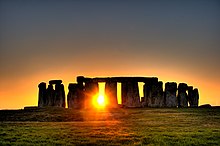
The oldest proto-human bones uncovered in the area date from 700,000 years ago. The discovery, of Homo erectus remains, was made in what is today Norfolk and Suffolk.[22] Modern humans first arrived in the area around 35,000 years ago;[8] but due to the tough conditions of the Last Ice Age, known specifically in this area as the Devensian glaciation,[23] they fled from Britain to the mountains of southern Europe. Only large mammals such as mammoths, bison and woolly rhinoceros remained.[8] Roughly 11,000 years ago, when the ice sheets began to recede, humans repopulated the area; genetic research suggests they came from the northern part of the Iberian Peninsula.[24] The sea level was lower than now; Britain was connected by land to both Ireland and Eurasia. As the seas rose, it was separated from Ireland 9,000 years ago and from Eurasia half a century later.[25] Beaker culture arrived around 2500 BC, and the making of food vessels constructed out of clay and copper was introduced.[26] It was during this time that major Neolithic monuments such as Stonehenge and Avebury were constructed. By heating together tin and copper, both of which were in abundance in the area, the Beaker culture people were able to make bronze and afterwards iron from iron ores. Using sheep's wool, they were able to spin and weave, developing clothing in preference to simple animal skins.[26]

During the Iron Age, Celtic culture, deriving from the Hallstatt and La Tène cultures, arrived from Central Europe. Many new developments were introduced. Iron smelting helped in creating better ploughs and thus agriculture advanced; smelting also helped the development of higher quality weapons.[26] Brythonic was the spoken language during this time. Society was tribal; according to Ptolemy's Geographia there were around twenty different tribes in the area, however earlier divisions are unknown because the Britons were not literate. Like other regions on the edge of the empire, Britain had long enjoyed trading links with the Romans. Julius Caesar of the Roman Republic attempted to invade twice in 55 BC; though largely unsuccessful, he managed to set up a client king from the Trinovantes. The Romans conquered Britain in AD 43 during the reign of Emperor Claudius, and the area was incorporated into the Roman Empire as Britannia province.[27] The best known of the native tribes who attempted to resist were the Catuvellauni led by Caratacus. Later, an uprising led by Boudica, queen of the Iceni, resulted in her death at Watling Street.[28] This era saw a Greco-Roman high culture prevail with the introduction of law and order, Roman architecture, personal hygiene, sewage systems, education, many agricultural items, and silk.[28] In the 3rd century, emperor Septimius Severus died at York, and in that city Constantine was proclaimed emperor.[29] Christianity was first introduced around this time, though there are traditions linked to Glastonbury claiming an introduction through Joseph of Arimathea, while others claim through Lucius of Britain.[30] With the decline of the Roman Empire the Romans had departed from the island by 410 to defend their frontiers in continental Europe.[28]
Middle Ages
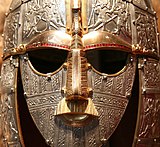
Following the Roman retreat, Britain was left open to invasion by pagan, seafaring warriors such as Saxons and Jutes who gained control in areas around the south east.[31] This advance was contained for a while after the Britons led the Battle of Mount Badon. In the north there were Sub-Roman Brythonic kingdoms, later known collectively by the British bards as the Hen Ogledd, however these too were gradually conquered by Angles during the 6th century. Reliable contemporary accounts from this period are scarce, as is archaeological evidence, meaning it was a Dark Age. There are various conflicting theories on the extent and process of the Anglo-Saxon invasion of Britain—to conflate the issue Cerdic, founder of the Wessex dynasty may have been a Briton.[32] Nevertheless, by the 7th century a coherent set of Anglo-Saxon petty kingdoms known as the Heptarchy had emerged in southern and central Britain: Northumbria, Mercia, East Anglia, Essex, Kent, Sussex, and Wessex.[33] Christianity was introduced in the south by Augustine from Rome and in the north by Aidan from Ireland. This reintroduced Christianity, which was lost after the founding of the Heptarchy in the region.[34] The title Bretwalda meaning Lord of the Britons denoted the most influential kingdom.[35] Northumbria and Mercia were the most dominant forces early on.[36] However, following Viking conquests in the north and east, with the insertion of Danelaw, the premier English kingdom became Wessex under Alfred the Great. His grandson Athelstan unified England in 927, though this was only made permanent when Edred defeated Eric Bloodaxe. A short-lived empire under Viking king Cnut the Great which included England, Denmark and Norway existed.[37] However the Wessex dynasty was restored under Edward the Confessor.

Its ties and nature, however, were forever changed following the Norman conquest of England in 1066.[why?] In the next few hundred years, English kings controlled parts of France, and the "Kings of England" used England as a source of troops to enlarge their personal holdings in France (Hundred Years' War). The English crown did not relinquish its last foothold on mainland France until Calais was lost, in 1558,[38] during the reign of Mary Tudor (the Channel Islands are still crown dependencies, though not part of the UK). In the 13th century Wales (the remaining Romano-Celts) was brought under the control of English monarchs by conquest. This was formalised in the Statute of Rhuddlan in 1284 and Wales was legally annexed to the Kingdom of England by the Laws in Wales Acts 1535–1542. Wales shared a legal identity with England as the joint entity originally called England, and later England and Wales. The Black Death, an epidemic of catastrophic proportions, first reached England in the summer of 1348. The Black Death is estimated to have killed between a third and two-thirds of Europe's population. England alone lost between a third to half of its inhabitants.[39][40] The plague repeatedly returned to haunt England throughout the 14th to 17th centuries. The Great Plague of London in 1665–1666 was the last such plague outbreak.[41]
Early Modern

During the English Reformation in the 16th century, the external authority of the Roman Catholic Church in England was abolished and replaced with Acts of Royal Supremacy and the establishment of the Church of England (Anglican Church) under the Supreme Governance of the English monarch. This occurred during the reign of Henry VIII. The English Reformation differed from its European counterparts in that its roots were more political than theological.[note 2] The English Reformation paved the way for the spread of Anglicanism in the church and other institutions. The period known as the English Civil War (1642–1651) saw political machinations and armed conflicts between supporters of the Long Parliament (Roundheads) and of King Charles I (Royalists) in the First English Civil War of 1642 to 1645 and Second English Civil War of 1648 to 1649, followed by conflict between supporters of the Rump Parliament and of King Charles II in the Third English Civil War of 1649 to 1651. The civil war ended with the Parliamentary victory at the Battle of Worcester on 3 September 1651. It had led to the trial and execution of Charles I, the exile of his son Charles II, the replacement of the English monarchy with the Commonwealth of England (1649–1653) and personal rule by Oliver Cromwell during The Protectorate (1653–1659).[43]

After Cromwell's death in 1659, a brief return to Commonwealth rule was attempted before Parliament invited Charles II to return to England in 1660 and restore the monarchy. During the interregnum, the Church of England's monopoly on Christian worship in England came to an end and the Protestant Ascendancy consolidated in Ireland. Constitutionally, the wars established a precedent that British monarchs could not govern without parliamentary consent, although this would not be cemented until the Glorious Revolution later in the century. Although embattled for centuries, the Kingdom of England and Kingdom of Scotland had been drawing increasingly together since the Protestant Reformation of the 16th century,[44] and in 1603, with the Scottish king James VI's accession to the English crown, the two countries became linked by a personal union, being ruled by the same Stuart dynasty.[45] Following a number of attempts to unite the Kingdoms, a Treaty of Union was agreed on 22 July 1706 by representatives of the English and Scottish parliaments,[46] and put into effect by the Acts of Union which resulted in political union between the states with the creation of the united Kingdom of Great Britain on 1 May 1707.[44] (Ireland joining in 1801 with all of Ireland except Northern Ireland leaving in 1922 has resulted in the current name of the United Kingdom of Great Britain and Northern Ireland).
Contemporary
After the Union, England (including Wales) retained its separate legal identity since the continuance and separation of Scots law was enshrined in the Articles of the Treaty of Union.[47] Wales was already part of the Kingdom of England but the Wales and Berwick Act 1746 made explicit that laws passed for England were automatically applicable to Wales. The Wales and Berwick Act 1746 also referred to the formerly Scottish burgh of Berwick-upon-Tweed. The border town changed hands several times and was last conquered by England in 1482,[48] but was not officially incorporated into England. Contention about whether Berwick was in England or Scotland was ended by the union of the two in 1707. Berwick remains within the English legal system and so is regarded today as part of England.[49] The county of Monmouthshire had been an ambiguous area from the 16th century, culturally Welsh but covered by England's legal arrangements; in the Local Government Act 1972 it was confirmed as part of Wales.[50] The Isle of Man and the Channel Islands are Crown dependencies and are not part of England nor the United Kingdom.[51][52]
Governance
Politics

As part of the United Kingdom the basic political system in England is a constitutional monarchy and parliamentary democracy. There has not been a Government of England since 1707, when the Acts of Union 1707, putting into effect the terms of the Treaty of Union, joined the England and Scotland to form the Kingdom of Great Britain.[46] Before the union England was ruled by its monarch and the Parliament of England. Today however England is governed directly by the Parliament of the United Kingdom, while other countries of the United Kingdom have devolved governments which England does not have.[53] In the House of Commons which is the lower house of the British Parliament based at the Palace of Westminster, there are 529 Members of Parliament for constituencies in England, out of the 646 total.[54] In the United Kingdom general election, 2005 the Labour Party had the most MPs elected in England with 284, while the Conservative Party had 194 MPs elected although they received a larger percentage of the popular vote than any other party with 35.7%.[55] The third largest party are the Liberal Democrats who had 47 MPs elected. Respect and Heath Concern each have one MP, and there is an Independent Labour member originally elected for Labour.[55] The two largest parties are led by Gordon Brown for Labour and David Cameron for Conservatives.
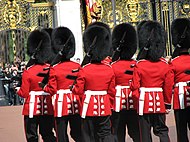
As the United Kingdom is a member of the European Union, there are elections held regionally in England to decide who is sent as Members of the European Parliament. The 2009 European Parliament election saw the regions of England elect the following MEPs: twenty-three Conservatives, ten Labour, nine United Kingdom Independence Party (UKIP), nine Liberal Democrats, two Greens and two British National Party (BNP).[56] Since devolution, in which other countries of the United Kingdom—Scotland, Wales and Northern Ireland—each have their own devolved parliament or assemblies for local issues, there has been debate about how to counterbalance this in England. Originally it was planned that various regions of England would be devolved, but this was rejected in a referendum.[57] One major issue is the West Lothian question, in which MPs from Scotland and Wales are able to vote on legislation effecting only Engand, while English MPs have no equivalent right to legislate on devolved matters.[58] This when placed in the context of England being the only country of the United Kingdom not to have free cancer treatment, prescriptions, residential care for the elderly and free top-up university fees,[59] has led to a steady rise in English nationalism.[60] Some have suggested the creation of a devolved English parliament,[61] while others have proposed simply limiting voting on legislation which only effects England to English MPs.[62]
Law

The English law legal system, developed over the centuries, is the foundation of many legal systems throughout the Anglosphere.[63] Despite now being part of the United Kingdom, the legal system of the Courts of England and Wales continued as a separate legal system to the one used in Scotland as part of the Treaty of Union. The general essence of English law is that it is made by judges sitting in courts, applying their common sense and knowledge of legal precedent—stare decisis—to the facts before them.[64] The court system is headed by the Supreme Court of Judicature, consisting of the Court of Appeal, the High Court of Justice for civil cases and the Crown Court for criminal cases.[65] The House of Lords is the highest court for both criminal and civil cases in England and Wales though constitutional changes will soon see those powers transfer to a new Supreme Court of the United Kingdom.[66] A decision of the highest appeal court in England and Wales, the House of Lords, is binding on every other court in the hierarchy, which follow its directions.[67] Crime increased between 1981–1995, though since then there has been 42% fall in crime for the period 1995–2006.[68] The prison population doubled over the same period, giving it the highest incarceration rate in Western Europe at 147 per 100,000.[69] Her Majesty's Prison Service reporting to the Ministry of Justice, manages most prisons, housing over 80,000 convicts.[69]
Regions, counties and districts
The subdivisions of England consist of as many as four levels of subnational division controlled through a variety of types of administrative entites. They have been created for the purposes of local government in England. The highest tier of local government are the nine regions of England—North East, North West, Yorkshire and the Humber, East Midlands, West Midlands, East, South East, South West and Greater London. These were created in 1994 as Government Offices, used by the British Government to deliver a wide range of policies and programmes regionally.[70] They are used for electing Members of the European Parliament on a regional basis. After devolution began to take place in other parts of the United Kingdom it was planned that referendums for the regions of England would take place for their own regional assemblies as a counterweight. London accepted in 1998—the London Assembly was created two years later. However, the proposal was rejected by the northern England devolution referendums, 2004 in the North East, further referendums were cancelled.[57] There are plans to abolish the remaining regional assemblies in 2010 and transfer their functions to respective Regional Development Agencies and new system of Local Authority Leaders’ Boards.[71]
Below the regional level all of England is divided into one of 48 ceremonial counties.[72] These counties are used primarily as a geographical frame of reference and have developed gradually since the Middle Ages, with some established as recently as 1974.[73] Each has a Lord Lieutenant and High Sheriff; these posts are used to represent the British monarch locally.[72] Outside Greater London and the Isles of Scilly, England is also divided into 83 metropolitan and non-metropolitan counties; these correspond to areas used for the purposes of local government[74] and may consist of a single district or be divided into several. There are six metropolitan counties which are based on the most heavily urbanised areas and do not have county councils.[74] In these areas the principle authorities are the councils of the subdivisions, the metropolitan boroughs. 27 non-metropolitan "shire" counties have a county council and are divided into districts, each with a district council. They are typically, though not always, found in more rural areas. The remaining non-metropolitan counties are of a single district and usually correspond to large towns or counties with low populations; they are known as unitary authorities. Greater London has a different system for local governance, with thirty-two London boroughs and the City of London covering a small area at the core, which is governed by the City of London Corporation.[75] At the most localised level, much of England is divided into parishes with councils; they do not exist in Greater London.[76]
Geography
Landscape and rivers
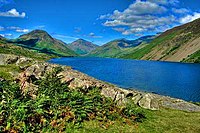
Geographically England comprises the central and southern two-thirds of the island of Great Britain, plus such offshore islands as the Isle of Wight and the Isles of Scilly. It is bordered by two fellow countries of the United Kingdom— to the north by Scotland and to the west by Wales. England is closer to the European Continent than any other part of mainland Britain. It is separated from France by a 34-kilometre (21 mi)[77] sea gap, though the two countries are connected by the Channel Tunnel near Folkestone.[78][79] As England is on an island, is it surrounded by the water of the Irish Sea, North Sea and Atlantic Ocean. The most important rivers in England, because of their ports of London, Liverpool and Newcastle, are the tidal rivers Thames, Mersey and Tyne.[80] The tides raise the level of water in their estuaries and enable ships to enter the ports. The longest river running through England is the Severn, which is 354 kilometres (220 mi) long and empties into the Bristol Channel; it is also notable for the Severn Bore tidal waves which can reach 2 metres (6.6 ft) in height.[80] However, the longest river entirely in England is the Thames, which is 346 kilometres (215 mi) long.[81] There are many lakes in England but the majority are in the aptly named Lake District; the largest of which is Lake Windermere, it is known by the nickname "Queen of Lakes".[80]
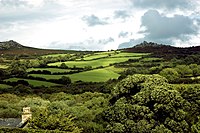
The Pennines which are known as the backbone of England, are the oldest range of mountains in the country originating from the end of the Paleozoic Era around 300 million years ago.[82] The total length of the Pennines is 400 kilometres (250 mi), peaking at Cross Fell in Cumbria.[80] The material which they are made up of itself is mostly sandstone and limestone, but also coal. There are karst landscapes in calcite areas such as parts of Yorkshire and Derbyshire. The Pennines landscape is high moorland in upland areas, indented by fertile valleys of the region's rivers.[80] They contain three national parts, the Yorkshire Dales, Northumberland and the Peak District. The highest point in England is Scafell Pike in Cumbria which is 978 metres (3,209 ft) high.[80] Straddling the border between England and Scotland are the Cheviot Hills. The English Lowlands are to the south of the Pennines, consisting of green rolling hills, including the Cotswold Hills, Chiltern Hills, North and South Downs—where they meet the sea they form white rock exposures such as the cliffs of Dover.[80] The granitic Southwest Peninsula in the West Country provides upland moorland, such as Dartmoor and Exmoor, which flourish with a mild climate; both are national parks.[80]
Climate
England has a temperate maritime climate meaning that it is mild with temperatures not much lower than 0 °C (32 °F) in winter and not much higher than 32 °C (90 °F) in summer.[83] The weather is damp relatively frequently and is subject to change. The coldest months are January and February, the latter particularly on the English coast, while July is normally the warmest month. Months with mild to warm weather with least rainfall are May, June, September and October.[83] The biggest influences on the climate of England comes from the proximity to the Atlantic Ocean, its northern latitude and warming of the waters around the Gulf Stream.[83] England receives quite a significant proportion of rainfall during the year, with autumn and winter being the wettest time—geographically the Lake District receives more rain than anywhere else in the country.[83] Since weather recording records began, the highest temperature received was 38.5 °C (101.3 °F) on 10 August 2003 at Brogdale in Kent,[84] while the lowest was −26.1 °C (−15.0 °F) on 10 January 1982 in Edgmond, Shropshire.[85]
| Climate data for England | |||||||||||||
|---|---|---|---|---|---|---|---|---|---|---|---|---|---|
| Month | Jan | Feb | Mar | Apr | May | Jun | Jul | Aug | Sep | Oct | Nov | Dec | Year |
| Source: Met Office[86] | |||||||||||||
Major conurbations
The Greater London Urban Area is by far the largest urban area in England[87] and one of the busiest cities in the world. It has a population larger than other countries in the United Kingdom besides England itself.[87] Other urban areas of considerable size and influence tend to be in northern England or the English Midlands.[87] There are fifty settlements which have been designated city status in England, while the United Kingdom in general has sixty-six. While many cities in England are quite large in size, such as Birmingham, Manchester, Liverpool, Leeds, Newcastle, Bradford, Nottingham and others, a large population is not necessarily a prerequisite for a settlement to be afforded city status.[88] Traditionally the status was afforded to towns with diocesan cathedrals and so there are smaller cities like Wells, Ely, Ripon, Truro and Chichester.[88] According to the Office for National Statistics the ten largest, continuous built-up urban areas are;[87]
| Rank | Urban Area | Population | Localities | Major localities |
|---|---|---|---|---|
| 1 | Greater London Urban Area | 8,278,251 | 67 | Greater London, divided into the City of London and 32 London boroughs including Croydon, Barnet, Ealing, Bromley |
| 2 | West Midlands Urban Area | 2,284,093 | 22 | Birmingham, Wolverhampton, Dudley, Walsall |
| 3 | Greater Manchester Urban Area | 2,240,230 | 57 | Manchester, Salford, Bolton, Stockport, Oldham |
| 4 | West Yorkshire Urban Area | 1,499,465 | 26 | Leeds, Bradford, Huddersfield, Wakefield |
| 5 | Tyneside | 879,996 | 25 | Newcastle, North Shields, South Shields, Gateshead, Jarrow |
| 6 | Liverpool Urban Area | 816,216 | 8 | Liverpool, St Helens, Bootle, Huyton-with-Roby |
| 7 | Nottingham Urban Area | 666,358 | 15 | Nottingham, Beeston and Stapleford, Carlton, Long Eaton |
| 8 | Sheffield Urban Area | 640,720 | 7 | Sheffield, Rotherham, Chapeltown, Mosborough |
| 9 | Bristol Urban Area | 551,066 | 7 | Bristol, Kingswood, Mangotsfield, Stoke Gifford |
| 10 | Brighton/Worthing/Littlehampton | 461,181 | 10 | Brighton, Worthing, Hove, Littlehampton, Shoreham, Lancing |
Economy
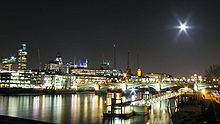
England's economy is the among the largest in in the world, it has an average GDP per capita of £22,907.[91] Usually regarded as a mixed market economy, although it takes on many free market principles compared to the Rhine Capitalism of Europe, England has an advanced social welfare infrastructure.[92] The official currency in England is the pound sterling also known as the GBP. Taxation in England is quite competitive when compared to much of Europe—the basic rate is 20% on taxable income up to £37,400, taxable income over that stands at 40%.[93] The economy of England is the largest part of the British economy;[91] combined with the other countries of the United Kingdom has the 18th highest GDP PPP per capita in the world. One of the world's most industrialised countries, England is a leader in the chemical and pharmaceutical sectors and in key technical industries, particularly aerospace, the arms industry and the manufacturing side of the software industry. At the centre of the financial economy is London which is home to the London Stock Exchange, the main stock exchange in the United Kingdom and the largest in Europe—one hundred of Europe's five hundred largest corporations are based in London.[94] London is the largest financial centre in Europe and currently the largest in the world.[95]
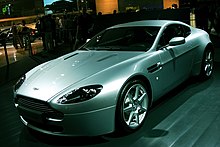
The Bank of England created in 1694 by Scottish banker William Paterson is the central bank of the United Kingdom. Originally created to act as private banker to the Government of England, it carried on in this role as part of the United Kingdom—since 1946 it has been a state-owned institution.[96] The Bank has a monopoly on the issue of banknotes in England and Wales, although not in other parts of the United Kingdom. Its Monetary Policy Committee has devolved responsibility for managing the monetary policy of the country and setting interest rates.[97] England is highly industrialised, but since the 1970s there has been a decline in traditional heavy and manufacturing industries, towards a more service industry dominated economy.[98] Tourism is a significant industry attracting millions of tourists each year. The export part of the economy is dominated by pharmaceuticals, automobiles—though many English created manufacturers are now foreign owned, such as Rolls-Royce, Lotus, Jaguar and Bentley which have headquarters in England, while Aston Martin remains English owned—crude oil and petroleum from the English parts of North Sea Oil along with Wytch Farm, aircraft engines and alcoholic beverages.[99] While agriculture is intensive and highly mechanised, producing 60% of food needs with only 2% of the labour force.[100] Two thirds of production is devoted to livestock, the other to arable crops.
Infrastructure

The Department for Transport is the government institute overseeing transport in England. Since the second half of the 20th century, major road-building programmes were undertaken to facilitate growth in automobile ownership. There are several motorways in England, one of the most important trunk roads is the A1 Great North Road, stretching across the country from London to Newcastle.[101] The longest motorway in England is the M6, stretching from Rugby to the North West up to the Anglo-Scottish border.[101] There are other major roads; the M1 from London to Leeds, the M25 which encircles London, the M60 which encircles Manchester, the M4 from London to South Wales, the M62 from Liverpool to Manchester and East Yorkshire and the M5 from Birmingham to Bristol and the South West.[101] Bus transport across the country is common, major companies include National Express, Arriva and Go-Ahead Group. The red double-decker buses in London have become a symbol of England. There is a rapid rail network in two English cities; the London Underground and the Tyne and Wear Metro, the latter in Newcastle, Gateshead and Sunderland.[102] There are tram networks, such as; Blackpool, Manchester Metrolink, Sheffield Supertram and Midland Metro.[102]

Rail transport in England is the oldest in the world, with the system originating there in 1825.[104] Much of Britain's 16,116 kilometres (10,014 mi) of rail network lies in England, covering the country extensively.[105] These lines are mostly single, double or quadruple track, though there are narrow gauge lines. There is rail transport access to France and Belgium through an undersea rail link, the Channel Tunnel which was completed in 1994. There are air transport facilities in England connected the public to numerous international locations, the largest airport is London Heathrow Airport which in terms of passenger volume in the busiest in Europe and one of busiest in the world.[103] Other large airports include Manchester Airport, London Stansted Airport, Luton Airport and Birmingham International Airport.[103] By sea there is ferry transport, both for internal and external trips, some of the most common links are to Ireland, the Netherlands and Belgium.[106] Travel by waterways such as rivers, canals, docks is common with around 7,100 km (4,400 mi) of navigable waterways in England, half of which is owned by British Waterways.[106] The Thames is the major waterway in England, with imports and exports focused at the Port of Tilbury, one of the three major ports in Britain.[106]

The National Health Service (NHS) is the publicly funded healthcare system in England responsible for providing the majority of healthcare in the country. The NHS began on 5 July 1948, putting into effect the provisions of the National Health Service Act 1946. It was based on the findings of the Beveridge Report, prepared by economist and social reformer William Beveridge.[107] The NHS is largely funded from general taxation including National Insurance payments,[108] it provides most services at no additional cost though there are extra charges associated with eye tests, dental care, prescriptions and aspects of personal care.[109] The government department responsible for the NHS is the Department of Health, headed by the Secretary of State for Health, who sits in the British Cabinet. Most of the expenditure of the Department of Health is spent on the NHS—£98.6 billion was spent in 2008-2009.[110] In recent years the private sector has been increasingly used to provide more NHS services despite opposition by doctors and trade unions.[111] The average life expectancy of people in England is 77.5 years for males and 81.7 years for females, the highest of the four countries of the United Kingdom.[112]
Demography
Population

With over 51 million inhabitants, England is the most populous country of the United Kingdom, accounting for 84% of the combined total.[113] England taken as a unit and measured against international states has the fourth largest population in the European Union and would be the 25th largest country by population in the world.[114] With a density of 395 people per square kilometre, it would be the second most densely populated country in the European Union after Malta.[115] Beyond Europe, England ranks third in population density after Bangladesh and South Korea.[116] The five largest urban areas in England are Greater London, the West Midlands, Greater Manchester, West Yorkshire and Tyneside.[117] The English people are a British people[3]—genetic evidence suggests that 75–95% descend in the paternal line from prehistoric settlers who originally came from the Iberian Peninsula.[118][119][120] There is a significant Norse element, as well as a 5% contribution from Angles and Saxons,[118] though some scholars place this estimate higher.[121] Recent genetic studies have shown that more than 50% of England's gene pool contains Germanic Y chromosomes.[122] Over time various cultures have been influential—Prehistoric, Brythonic,[123] Roman, Angle, Saxon,[124] Norse Viking,[125] Gaelic cultures, as well as a large influence from Normans. There is an English diaspora in former parts of the British Empire; especially the United States, Canada, Australia, Chile, South Africa and New Zealand.[note 3] Since the late 1990s, English people have migrated to Spain.[130][131]

At the time of the Domesday Book, compiled in 1086, more than 90% of the English population of about two million lived in the countryside.[132] By 1801 the population had grown to 8.3 million, and by 1901 had grown to 30.5 million.[133] Industrial and commercial expansion in the late 18th, 19th and early 20th centuries, and growing ease of communications, fuelled migration between all parts of British Isles. Due to the economic prosperity in South East England there are many economic migrants from the other parts of the United Kingdom.[3] There has been significant Irish migration, with 25% of English people having Irish ancestry.[134] The white population totals out at 89.90%, including Germans[134] and Poles.[3] Outside of this people from much further afield in the former British colonies have arrived since the 1950s—5.30% of people living in England have migrated from the Indian subcontinent, mostly India and Pakistan.[3][134] 2.30% of the population are black, mostly from the Caribbean.[3][134] There is a significant number of Chinese and British Chinese.[3][134] As of 2007, 22% of primary school children and 17.7% of children at secondary school in England were from ethnic minority families.[135]
About half of population increase between 1991–2001 was due to foreign-born immigration. During the period 1991–2001 a net 726,000 immigrants arrived in London.[136] Debate over immigration is politically prominent,[137] according to a Home Office poll 80% of people want to cap it.[138] The Office for National Statistics has projected a continuing growth in the population, estimating between the years 2004–2029 a six million figure growth.[139] A projected increase of more than 20% by 2029.[139]
Language
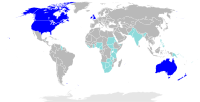
As its name suggests, the English language, today spoken by hundreds of millions of people around the world, originated as the language of England, where it remains the principal tongue today, although not officially designated as such. An Indo-European language in the Anglo-Frisian branch of the Germanic family, it is closely related to Scots.[140] After the Norman conquest, the Old English language was displaced and confined to the lower social classes as Norman French and Latin were used by the aristocracy. By the 17th century, English came back into fashion among all classes, though much changed; the Middle English form showed many signs of French influence, both in vocabulary and spelling. During the English Renaissance, many words were coined from Latin and Greek origins;[141] Modern English has extended this custom of flexibility.
It is most commonly accepted that—thanks in large part to the British Empire—the English language is now the world's unofficial lingua franca.[142] English language learning and teaching is an important economic sector, including language schools, tourism spending, and publishing houses. There is no United Kingdom legislation in respect of language use within England,[143] but English is the only language used in England for general official business. Despite the relatively small size of the nation, there are many distinct English regional accents. Those with particularly strong accents may not be easily understood elsewhere in the country. Revivalists and enthusiasts have attempted to revive extinct Brythonic languages such as Cornish as a second or third tongue, in the county of Cornwall 0.1%[144] have the ability to speak the modern reconstruction which uses Welsh and Breton.[145] It is supported by the government under the ECRM, yet the United Nations has placed it on a list as extinct.[146]
Education
Universities and learning institutions

The body responsible for state education in general up to the age of 19, in the United Kingdom is the Department for Children, Schools and Families—this body directly controls state schools in England.[147] Funded through taxation state-run schools are attended by approximately 93% of English schoolchildren.[148] There are a minority of faith schools, mostly Church of England or Catholic Church ran. Between three and four is nursery school, four and eleven is primary school and then eleven to sixteen is secondary school with an option for a two year extension to attend sixth form college. Although most English secondary schools are comprehensive, there are selective intake grammar schools which can be entered by passing the eleven plus exam. Around 7.2% of English schoolchildren attend private schools which are funded by private sources.[149] Standards are monitored by regular inspections of state-funded schools by the Office for Standards in Education and of private schools by the Independent Schools Inspectorate.[150]
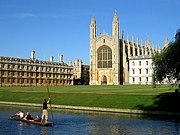
After finishing compulsory education, pupils take a GCSE examination. Following this people may decide to continue with further education and attend a further education college. Students normally enter University from 18 onwards and study for an Academic Degree. There are more than 90 state funded universities in England which are monitored by the Department for Innovation, Universities and Skills,[151] students are generally entitled to student loans for maintenance.[note 5] The first degree offered to undergraduates is the Bachelor's degree, taking three years. Students are then eligible for a postgraduate degree which includes the Master's degree, taking one year and Doctorate degree taking three. England has a strong history of promoting education and its top institutions enjoy a respected reputation internationally.[152] Perhaps the best know universities are Oxford University and Cambridge University. The King's School, Canterbury and The King's School, Rochester are the oldest schools in the English speaking world.[153] The most famous schools in England are now fee-paying institutions, including Winchester College, Eton College, St Paul's School, Rugby School and Harrow School.[154]
Science, engineering and innovation

Prominent English figures from the field of science and mathematics include Sir Isaac Newton, Michael Faraday, Robert Hooke, Robert Boyle, Joseph Priestley, J. J. Thomson, Charles Babbage, Charles Darwin, Stephen Hawking, Christopher Wren, Alan Turing, Francis Crick, Joseph Lister, Tim Berners-Lee, Andrew Wiles and Richard Dawkins. Experts claim that the earliest concept of a Metric system was invented by John Wilkins, first secretary of the Royal Society in 1668.[155] As birthplace of the Industrial Revolution, England was home to many significant inventors during the late 18th and early 19th century. Famous English engineers include Isambard Kingdom Brunel, best known for the creation of the Great Western Railway, a series of famous steamships, and numerous important bridges, hence revolutionising public transport and modern-day engineering.[156]
Inventions and discoveries of the English include; the first industrial spinning machine, the first computer and the modern computer, the World Wide Web along with HTTP and HTML, performance of the first blood transfusion, the vacuum cleaner, the lawnmower, the seat belt, the hovercraft, the electric motor, the microphone and steam engines. Theories such as the Darwinian theory of evolution and the atomic theory.[157] Newton was the promulgator of universal gravitation, Newtonian mechanics and infinitesimal calculus, while Robert Hooke promulgator the Hooke's law of elasticity. Other inventions include the iron plate railway, the thermosiphon, tarmac, the rubber band, the mousetrap, "cat's eye" road safety device, joint development of the light bulb, steam locomotives, the seed drill, the jet engine and many modern techniques and technologies used in precision engineering.[157]
Religion

Christianity is the most widely practiced religion in England and has been since the Early Middle Ages, though its existence on the island dates back to the Gaelic and Roman introduction in antiquity and continued through Early Insular Christianity. Around 71.6% of English people identify as Christians.[158] The largest form practiced in the present day is Anglicanism,[159] dating from the 16th century Reformation period, with the 1536 split from Rome over Henry VIII wanting to divorce Catherine of Aragon, the religion regards itself as both Catholic and Reformed. There are both High Church and Low Church traditions, with a portion of Anglicans regarding themselves as Anglo-Catholics after the Tractarian movement. Head of the Church is the monarch of the United Kingdom as the Supreme Governor. It has the status of established church in England. There are around 26 million adherents to the Church of England and they form part of the Anglican Communion with the Archbishop of Canterbury acting as the symbolic worldwide head.[160] Many cathedrals and parish churches are historic buildings of significant architectural importance, such as Westminster Abbey, York Minster, Durham Cathedral and Salisbury Cathedral.

The second largest Christian practice is the Latin Rite of the Catholic Church which traces its formal, corporate history in England to the 6th century with Augustine's mission and was the main religion on the entire island for around a thousand years. Since its reintroduction after the Catholic Emancipation, the Church has organised ecclesiastically on an England and Wales basis where there are 4.5 million members (most of whom are English).[161] There has been one Pope from England to date, Adrian IV; while saints Bede and Anslem are regarded as Doctors of the Church. A form of Protestantism known as Methodism is the third largest and grew out of Anglicanism through John Wesley.[162] It gained popularity in the mill towns of Lancashire and Yorkshire, and amongst tin miners in Cornwall.[163] There are other non-conformist minorities, such as Baptists, Quakers, Congregationalists, Unitarians and the Salvation Army.[164]
The patron saint of England is Saint George, he is represented in the national flag, as well as the Union Flag as part of a combination.[165][165] There are many other English and associated saints, some of the best known include; Cuthbert, Alban, Wilfrid, Aidan, Edward the Confessor, John Fisher, Thomas More, Petroc, Piran, Margaret Clitherow and Thomas Becket.[166] There are non-Christian religions practiced. Jews have a history of a small minority on the island since 1070.[167] They were expelled from England in 1290 following the Edict of Expulsion, only to be allowed back in 1656.[167] Especially since the 1950s Eastern religions from the former British colonies have began to appear, due to foreign immigration; Islam is the most common of these accounting for around 3.1% in England.[158] Hinduism, Sikhism and Buddhism are next in number adding up to 2% combined,[158] introduced from India and South East Asia.[158] Around 14.6% claim to have no religion.[158] Prior to the rise of Christianity in England, Anglo-Saxon polytheism was practiced, and prior to the introduction of Christianity to Britain, the British isles were home to Celtic polytheism and Roman polytheism.
Culture
Architecture

Many ancient standing stone monuments were erected during the prehistoric period, amongst the best known are Stonehenge, Devil's Arrows, Rudston Monolith and Castlerigg.[168] With the introduction of Ancient Roman architecture there was a development of basilicas, baths, amphitheaters, triumphal arches, villas, Roman temples, Roman roads, Roman forts, stockades and aqueducts.[169] It was the Romans who founded the first cities and towns such as London, Bath, York, Chester and St Albans. Perhaps the best known example is Hadrian's Wall stretching right across northern England.[169] Another well preserved example is the Roman Baths at Bath, Somerset.[169] Early Medieval architecture's secular buildings were simple constructions mainly using timber with thatch for roofing. Ecclesiastical architecture ranged from a synthesis of Hiberno—Saxon monasticism,[170][171] to Early Christian basilica and architecture characterised by pilaster-strips, blank arcading, baluster shafts and triangular headed openings. After the Norman conquest in 1066 various Castles in England were created so law lords could uphold their authority and in the north to protect from invasion. Some of the best known medieval castles include the Tower of London, Warwick Castle, Durham Castle and Windsor Castle amongst others.[172]
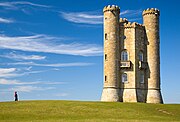
Throughout the Plantagenet era an English Gothic architecture flourished—the medieval cathedrals such as Canterbury Cathedral, Westminster Abbey and York Minster are prime examples.[172] Expanding on the Norman base there was also castles, palaces, great houses, universities and parish churches. Medieval architecture was completed with the 16th century Tudor style; the four-centred arch, now known as the Tudor arch, was a defining feature as were wattle and daub houses domestically. In the aftermath of the Renaissance a form of architecture echoing classical antiquity, synthesised with Christianity appeared—the English Baroque style, architect Christopher Wren was particularly championed.[173] Georgian architecture followed in a more refined style, evoking a simple Palladian form; the Royal Crescent at Bath is one of the best examples of this. With the emergence of romanticism during Victorian period, a Gothic Revival was launched—in addition to this around the same time the Industrial Revolution paved the way for buildings such as The Crystal Palace. Since the 1930s various modernist forms have appeared whose reception is often controversial, though traditionalist resistance movements continue with support in high places.[note 6]
Folklore

English folklore developed over many centuries. A few are present across England, but most belong to specific regions. Common folkloric beings include pixies, giants, elfs, bogeymen, trolls, goblins and dwarves. Most folklore traditions are no longer widely believed.
Many folkish figures are based on historical people: Lady Godiva was said to have ridden naked through Coventry, Hereward the Wake was an English figure who resisted the Normans, and Mother Shipton was a famous "witch".[175] The chivalrous bandit is also common (Dick Turpin being an example), while Blackbeard is the archetypal pirate.
While many legends and folk-customs are thought to be ancient (e.g. Offa of Angeln, Weyland Smith, Maypoles and Sword dances)[176] [177] [178] [179], others date from after the Norman invasion; Robin Hood and his Merry Men of Sherwood and their battles with the Sheriff of Nottingham being, perhaps, the best known.[180]
After the Norman invasion, another strand of tales entered English folklore, with origins in Brythonic traditions, particularly in Wales and the north and west of what is now England, which date back to the time of the Anglo-Saxon invasions; the Arthurian myth.[181][182][183] King Arthur, Camelot, Excalibur, Merlin and the Knights of the Round Table (Lancelot being a famous example) come from a variety of Anglo-Norman, French and Welsh sources[182] and may have come to prominence, at least in part, as an attempt by the Norman elite to legitimise their rule of the British Isles, finding Anglo-Saxon history ill-suited to the task at an era when members of the House of Wessex (especially Edgar Atheling and his Scottish nephews) were still prominent in the isles[182].[184] These stories are brought together in Geoffrey of Monmouth's Historia Regum Britanniae which were inspired by older histories and various Welsh texts[185]. Another early figure from British tradition, King Cole, may have been based on a real figure from post-Roman Britain. Many of these tales make up the Matter of Britain, a long pseudo-history that stretches from the fictitious founding of Britain by Brutus to the Anglo-Saxon invasion and settlement. Michael Wood explains; "Over the centuries the figure of Arthur became a symbol of British history - a way of explaining the 'matter' of Britain, the relationship between the Saxons and the Celts, and a way of exorcising ghosts and healing the wounds of the past."[181]
Many customs are still extant today, such as Guy Fawkes night on the 5th November. Folk traditions include Morris dancing, Maypole dancing, Rapper sword (North East), Long Sword dance (Yorkshire), Mummers Plays, bottle-kicking (Leicestershire) and cheese-rolling.[186] There is no official national costume, but a few are well established such as the Pearly Kings and Queens, Morris costume[187], the Royal Guard and Beefeaters.[188]
Cuisine

Since the Early Modern Period the food of England has historically been characterised by its simplicity of approach such as meat and two veg, honesty of flavour, and a reliance on the high quality of natural produce.[189] During the Middle Ages and through the Renaissance period, English cuisine enjoyed an excellent reputation, though a decline began during the Industrial Revolution with the move away from the land and increasing urbanisation of the populace. The French sometimes referred to English people as les rosbifs, as a stereotype to suggest English food is crude or unsophisticated.[190] However, the cuisine of England has recently had a more positive revival with the critics, with some good ratings in Restaurant's best restaurant in the world charts.[191] An early book of English recipes is the Forme of Cury from the royal court of Richard II.[192]
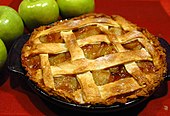
Traditional examples of English food include the Sunday roast; featuring a roasted joint, usually beef, lamb or chicken, served with assorted boiled vegetables, Yorkshire pudding and gravy.[193] Other prominent meals include fish and chips and the full English breakfast—consisting of bacon, grilled tomatoes, fried bread, black pudding, baked beans, fried mushrooms, sausages and eggs. Various meat pies are consumed such as steak and kidney pie, shepherd's pie, cottage pie, Cornish pasty and pork pie, the later of which is consumed cold.[193] Sausages are commonly eaten, either as bangers and mash or toad in the hole. Lancashire hotpot is a well known stew. Some of the most popular cheeses are Cheddar and Wensleydale. Many Anglo-Indian hybrid dishes, curries, have been created such as chicken tikka masala and balti. Sweet English dishes include apple pie, mince pies, spotted dick, scones, Eccles cakes, custard and sticky toffee pudding. Common drinks include tea, which became far more widely drunk due to Catherine of Braganza,[194] while alcoholic drinks include wines and English beers, usually drank in public houses such as bitter, mild, stout and brown ale.[195]
Visual arts
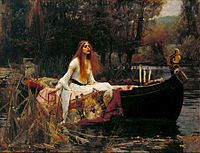
The earliest known examples are the prehistoric rock and cave art pieces, most prominent in North Yorkshire, Northumberland and Cumbria, but also feature further south, for example at Creswell Crags.[196] With the arrival of Roman culture in the 1st century, various forms of art utilising statues, busts, glasswork and mosaics were the norm. There are numerous surviving artefacts, such as those at Lullingstone and Aldborough.[197] During the Early Middle Ages the style was sculpted crosses and ivories, manuscript painting, gold and enamel jewellery, demonstrating a love of intricate, interwoven designs. Some of these blended Gaelic and Anglian styles, such as the Lindisfarne Gospels and Vespasian Psalter.[198] Later Gothic art was popular at Winchester and Canterbury, examples survive such as Benedictional of St. Æthelwold and Luttrell Psalter.[199]
The Tudor era saw prominent artists as part of their court, portrait painting which would remain an enduring part of English art, was boosted by German Hans Holbein, natives such as Nicholas Hilliard built on this.[199] Under the Stuarts, Continental artists were influential especially the Flemish, examples from the period include—Anthony van Dyck, Peter Lely, Godfrey Kneller and William Dobson.[199] The 18th century was a time of significance with the founding of the Royal Academy, a classicism based on the High Renaissance prevailed—Thomas Gainsborough and Joshua Reynolds became two of England's most treasured artists.[199] The Norwich School continued the landscape tradition, while the Pre-Raphaelite Brotherhood with their vivid and detailed style revived the Early Renaissance style—Holman Hunt, Dante Gabriel Rossetti and John Everett Millais were leaders.[199] Prominent amongst twentieth century artists was Henry Moore, regarded as the voice of British sculpture, and of British modernism in general.[200]
Literature, poetry and philosophy
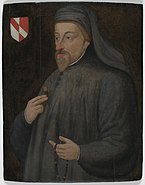
Early authors wrote in Latin such as Bede and Alcuin.[201] While the period of Old English literature provided the epic poem Beowulf, the secular prose the Anglo-Saxon Chronicle,[202] along with Christian writings such as Judith, Cædmon's Hymn and saintly hagiographies.[201] Following the Norman conquest Latin continued amongst the educated classes, as well as an Anglo-Norman literature. Middle English literature emerged with Geoffrey Chaucer author of The Canterbury Tales, along with Gower, the Pearl Poet and Langland. Franciscans, William of Ockham and Roger Bacon were major philosophers of the Middle Ages. Julian of Norwich with her Revelations of Divine Love was a prominent Christian mystic. With the English Renaissance literature in the Early Modern English style appeared. William Shakespeare, whose works include Hamlet, Romeo and Juliet, Macbeth, and A Midsummer Night's Dream, remains one of the most championed authors in English literature.[203] Marlowe, Spenser, Sydney, Kyd, Donne, Jonson are other giants of the Elizabethan age.[204] Francis Bacon and Thomas Hobbes wrote on empiricism and materialism, including scientific method and social contract.[204] Filmer wrote on the Divine Right of Kings. Marvell was the best known poet of the Commonwealth,[205] while John Milton authored Paradise Lost during the Restoration.
This royal throne of kings, this sceptred isle, this earth of majesty, this seat of Mars, this other Eden, demi-paradise; this fortress, built by nature for herself. This blessed plot, this earth, this realm, this England.
Some of the most prominent philosophers from the Enlightenment were Locke, Paine, Johnson and Benthem. More radical elements were later countered by Edmund Burke who is regarded as the founder of conservatism.[207] The poet Alexander Pope with his satirical verse became well regarded. The English played a significant role in romanticism—Coleridge, Byron, Keats, M Shelley, PB Shelley, Blake and Wordsworth were major figures.[208] In response to the Industrial revolution, agrarian writers looked to find a way between liberty and tradition; Cobbett, Chesterton and Belloc were main exponents, while founder of guild socialism, Penty and cooperative movement advocate Cole are somewhat related.[209] Empiricism continued through Mill and Russell, while Williams was involved in analytics. Authors from around the time of the Victorian era include Dickens, Brontë sisters, Austen, Kipling, Wells, and Underhill.[210] Since then England has continued to produce novelists such as C. S. Lewis, Orwell, Blyton, Christie, Tolkien, and J. K. Rowling.[211]
Performing arts
The traditional folk music of England is centuries old and has contributed to several genres prominently; mostly sea shanties, jigs, hornpipes and dance music. It has its own distinct variations and regional peculiarities. Wynkyn de Worde printed ballads of Robin Hood from the 16th century are an important artefact, as are John Playford's The Dancing Master and Robert Harley's Roxburghe Ballads collections.[212] Some of the best known songs are The Good Old Way, Pastime with Good Company, Maggie May and Spanish Ladies amongst others. Many nursery rhymes are of English origin such as Twinkle Twinkle Little Star, Roses are red, Jack and Jill, Here We Go Round the Mulberry Bush and Humpty Dumpty.[213] Early English composers in classical music include Renaissance artists Thomas Tallis and William Byrd, followed up by Henry Purcell from the Baroque period. German-born George Frideric Handel became a British subject[214] and spent most of his composing life in London, creating some of the most well-known works of classical music, The Messiah, Water Music, and Music for the Royal Fireworks. There was a revival in the profile of composers from England in the 20th century with Benjamin Britten, Frederick Delius, Edward Elgar, Gustav Holst, Ralph Vaughan Williams and others.[215] Present day composers from England include Michael Nyman, best known for The Piano.
In the field of popular music many English bands and solo artists have been cited as the most influential and best-selling musicians of all time. Acts such as The Beatles, Led Zeppelin, Pink Floyd, Elton John, Queen, Rod Stewart and The Rolling Stones are among the highest selling recording artists in the world.[216] Many musical genres have origins or strong associations with England, such as British invasion, hard rock, glam rock, heavy metal, mod, britpop, drum and bass, progressive rock, punk rock, indie rock, gothic rock, shoegazing, acid house, UK garage, trip hop and dubstep.[217] Large outdoor music festivals in the summer and autumn are popular, such as Glastonbury, V Festival, Reading and Leeds Festivals. The most prominent opera house in England is the Royal Opera House at Covent Gardens.[218] A major cultural event held annually is The Proms, a season of orchestral classical music concerts held at the Royal Albert Hall.[218] Classical ballet in England is performed by of one of the world's foremost ballet companies, The Royal Ballet, its reputation built on two prominent figures of twentieth century dance, prima ballerina Margot Fonteyn and choreographer Frederick Ashton.
Museums, libraries and galleries
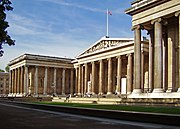
English Heritage is a governmental body with a broad remit of managing the historic sites, artefacts and environments of England. It is currently sponsored by the Department for Culture, Media and Sport. The charity National Trust for Places of Historic Interest or Natural Beauty holds a contrasting role. Seventeen of the twenty-five United Kingdom UNESCO World Heritage Sites fall within England.[219] Some of the best known of these include; Hadrian's Wall, Stonehenge, Avebury and Associated Sites, Tower of London, Jurassic Coast, Saltaire, Ironbridge Gorge, Studley Royal Park and various others.[220] There are many museums in England, but the most notable of all is London's British Museum. Its collections, which number more than seven million objects,[221] are amongst the largest and most comprehensive in the world[222] and originate from all continents, illustrating and documenting the story of human culture from its beginning to the present. The British Library in London is the national library and is one of the world's largest research libraries, holding over 150 million items in all known languages and formats; including around 25 million books.[223] The most senior art gallery is the National Gallery in Trafalgar Square, which houses a collection of over 2,300 paintings dating from the mid-13th century to 1900.[224] The Tate galleries house the national collections of British and international modern art; they also host the famously controversial Turner Prize.[225]
Sports
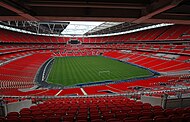
England has a very strong sporting heritage and codified many sports in the 19th century which are now played around the world. Sports originating in England include association football,[227] cricket, rugby union, rugby league, tennis, badminton, squash,[228] rounders,[229] hockey, boxing, snooker, billiards, curling, darts, table tennis, bowls, netball, thoroughbred horseracing and fox hunting. It has helped the development of sailing and Formula One. Football is the most popular of these sports. The England national football team, who play at Wembley Stadium, won the FIFA World Cup in 1966, the year the country hosted the competition. At club level England is recognised by FIFA as the birth-place of club football, due to Sheffield FC founded in 1857 being the oldest club.[227] The Football Association is the oldest of its kind, FA Cup and The Football League were the first cup and league competitions respectively. In the modern day the Premier League is the world's most lucrative football league[230] and amongst the elite.[231] The European Cup has been won by Liverpool, Manchester United, Nottingham Forest and Aston Villa, while Arsenal, Chelsea and Leeds United have reached the final.[232]
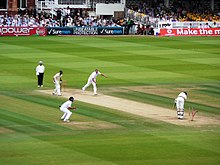
Cricket is generally thought to have been developed in the early medieval period among the farming and metalworking communities of the Weald.[233] The England cricket team is a composite England and Wales team. One of the game's top rivalries is The Ashes series between England and Australia, competed since 1882. The finale of the 2009 Ashes was watched by nearly 2 million people, although the climax of the 2005 Ashes was viewed by 7.4 million as it was available on terrestrial television.[234] England are the current holders of the trophy and are fifth in both Test and One Day International cricket.[235] England has hosted four Cricket World Cups (1975, 1979, 1983, 1999) and the ICC World Twenty20 in 2009. There are several domestic level competitions, including the County Championship in which Yorkshire are by far the most successful club having won the competition 31 times.[236] Lord's Cricket Ground situated in London is sometimes referred to as the "Mecca of Cricket".[237]

The England national rugby union team won the 2003 Rugby World Cup, the country was one of the host nations of the competition in the 1991 Rugby World Cup and is set to host the 2015 Rugby World Cup.[238] The top level of club participation is the English Premiership. Leicester Tigers, London Wasps, Bath Rugby and Northampton Saints have had success in the Europe-wide Heineken Cup. In another form of the sport—rugby league which was born in Huddersfield in 1898, the England national rugby league team are ranked third in the world and first in Europe. Since 2008 England has become a full test nation in lieu of the Great Britain national rugby league team, which won three World Cups but is now retired. At a domestic level, clubs previously played in the Rugby League Championship, now known as the Super League. Some of the most successful clubs include Wigan Warriors, St Helens, Leeds Rhinos and Huddersfield Giants; the former three have all won the World Club Challenge previously. In tennis the Wimbledon Championships are the oldest tennis tournament in the world and is widely considered the most prestigious.[239][240]
William Penny Brookes was prominent in organising the format for the modern Olympic Games—London has hosted the Summer Olympics in 1908 and 1948, as well as being set to host in 2012. The Commonwealth Games held every four years is competed in by England. Sport England is the governing body responsible for distributing funds and providing strategic guidance for sporting activity in England. A Grand Prix is usually held at Silverstone but will be moved to Donington.[241]
National symbols

The national flag of England, known as St. George's Cross, has been the national flag since the 13th century. Originally the flag was used by the maritime state the Republic of Genoa. The English monarch paid a tribute to the Doge of Genoa from 1190 onwards, so that English ships could fly the flag as a means of protection when entering the Mediterranean. A red cross acted as a symbol for many Crusaders in the 12th and 13th centuries. It became associated with Saint George, along with countries and cities, which claimed him as their patron saint and used his cross as a banner.[242] Since 1606 the St George's Cross has formed part of the design of the Union Flag, a Pan-British flag designed by King James I.[165]

There are numerous other symbols and symbolic artefacts, both official and unofficial, including the Tudor rose, the nation's floral emblem, the White Dragon and the Three Lions featured on the nation's coat of arms. The Tudor rose was adopted as a national emblem of England around the time of the Wars of the Roses as a symbol of peace.[243] It is a syncretic symbol in that it merged the white rose of the Yorkists and the red rose of the Lancastrians—cadet branches of the Plantagenets who went to war over control of the royal house. It is also known as the Rose of England.[244] The oak tree is a symbol of England, representing strength and endurance. The term Royal Oak is used to denote the escape of King Charles II from the grasps of the parliamentarians after his father's execution; he hid in an oak tree to avoid detection before making it safely into exile.
The national coat of arms of England, featuring three lions dates back to its adoption by Richard the Lionheart from 1198–1340. They are described as gules, three lions passant guardant or and provide one of the most prominent symbols of England; it is similar to the traditional arms of Normandy. England does not have an official designated national anthem, as the United Kingdom as a whole has God Save the Queen. However, the following are often considered unofficial English national anthems: Jerusalem, Land of Hope and Glory (used for England during the 2002 Commonwealth Games),[245] and I Vow to Thee, My Country. England's National Day is St George's Day, as Saint George is the patron saint of England, it is held annually on 23 April.[246]
References
Footnotes
- ^ Marden, Home Lover's Library, 460.
- ^ Brewer, Wordsworth Dictionary of Phrase and Fable, 340.
- ^ a b c d e f g "Ethnic group: Census 2001, Key Statistics for local Authorities". Statistics.gov.uk. Retrieved 2009-09-05.
- ^ "Population Estimates by Ethnic Group (experimental)". Statistics.gov.uk. Retrieved 2009-09-05.
- ^ "The Countries of the UK". Statistics.gov.uk. Retrieved 2009-02-01.
- ^ "Countries within a country". Number-10.gov.uk. Archived from the original on 2008-02-09. Retrieved 2009-02-01.
- ^ "Changes in the list of subdivision names and code elements (Page 11)" (PDF). International Organization for Standardization. Retrieved 2009-02-01.
- ^ a b c "10,000 to 200,000 Years Ago". HistoryofEngland.net. Retrieved 2009-09-05.
- ^ "England - Culture (login required)". BritainUSA. Retrieved 2009-02-01.
- ^ "Country profile: United Kingdom". BBC News. Retrieved 2009-02-01.
- ^ "Industrial Revolution". Ace.mmu.ac.uk. Retrieved 2009-02-01.
- ^ "History of the Royal Society". The Royal Society. Retrieved 2009-02-01.
- ^ "Oxford DNB theme: England, Scotland, and the Acts of Union (1707)". Oxford Dictionary of National Biography. Retrieved 2007-06-19.
- ^ Ripley, The New American Cyclopædia, 570.
- ^ "England". Oxford English Dictionary. Retrieved 2009-09-05.
- ^ "Germania". Tacitus. Retrieved 2009-09-05.
- ^ "Angle". Oxford English Dictionary. Retrieved 2009-09-05.
- ^ a b Massey, A Book of the Beginnings, Vol.1, 440.
- ^ Room, Placenames of the World, 23.
- ^ Major, History in Quotations, 84.
- ^ Foster Damon, A Blake dictionary, 9.
- ^ "Bone find may rewrite history". BBC.co.uk. Retrieved 2009-09-05.
- ^ "Glaciation" (PDF). BNSC.gov.uk. Retrieved 2009-09-05.
- ^ Oppenheimer, Origins of the British, 173.
- ^ "Tertiary Rivers: Tectonic and structural background". University of Cambridge. Retrieved 2009-09-09.
- ^ a b c "3000 to 4000 Years Ago". HistoryofEngland.net. Retrieved 2009-09-05.
- ^ "Dig uncovers Boudicca's brutal streak". The Observer. Retrieved 2009-09-05.
- ^ a b c "2000 Years Ago". HistoryofEngland.net. Retrieved 2009-09-05.
- ^ Rankov, The Praetorian Guard, 16.
- ^ Wright, The Christian Travel Planner, 143.
- ^ "Anglo-Saxons". BBC.co.uk. Retrieved 2009-09-05.
- ^ Clemoes, Anglo-Saxon England, 31.
- ^ Kirby, The earliest English kings, 4.
- ^ "The Christian Tradition". PicturesofEngland.com. Retrieved 2009-09-05.
- ^ BiblioBazaar, Encyclopædia Britannica, 28.
- ^ Lyon, A constitutional and legal history of medieval England, 23.
- ^ "1500 Years Ago". HistoryofEngland.net. Retrieved 2009-09-05.
- ^ "Calais". Le Poulet Gauche. Retrieved 2009-09-09.
- ^ Ziegler, The Black Death, 230.
- ^ Goldberg, The Black Death in England, 4.
- ^ "Spread of the Plague". BBC.co.uk. Retrieved 2009-09-05.
- ^ Scruton, A Dictionary Political Thought, 470.
- ^ "Oliver Cromwell (English statesman)". Encyclopædia Britannica. Encyclopædia Britannica Online. 2009. Retrieved 2009-08-08.
- ^ a b Colley, Britons: Forging the Nation, 12
- ^ "Making the Act of Union". Parliament.uk. Retrieved 2009-09-05.
- ^ a b "The first Parliament of Great Britain". Parliament.uk. Retrieved 2009-09-05.
- ^ "The Treaty (act) of the Union of Parliament 1706". Scots History Online. ScotsHistoryOnline.co.uk. 2009-04-04. Retrieved 2009-08-08.
- ^ "Berwick-upon-Tweed". Encyclopædia Britannica. Encyclopædia Britannica Online. 2009. Retrieved 2009-08-08.
- ^ Hamilton, Alan (2008-02-13). "Berwick thinks it's time to change sides ... again". The Times. Retrieved 2009-09-08.
- ^ "The coming of the Tudors and the Act of Union". BBC Wales. 2009. Retrieved 2009-09-09.
- ^ "Isle of Man". Encyclopædia Britannica. Encyclopædia Britannica Online. 2009. Retrieved 2009-08-09.
- ^ "Channel Islands". Encyclopædia Britannica. Encyclopædia Britannica Online. 2009. Retrieved 2009-08-09.
- ^ "Devolution in the United Kingdom". Cabinet Office. CabinetOffice.gov.uk. 2009-03-26. Retrieved 2009-08-16.
- ^ "Parliamentary Elections" (PDF). Parliament.uk. Retrieved 2009-09-05.
- ^ a b "Election 2005, results in England". BBC.co.uk. Retrieved 2009-09-05.
- ^ "European Election 2009: UK Results". BBC.co.uk. Retrieved 2009-09-05.
- ^ a b "Prescott's dream in tatters as North East rejects assembly". TimesOnline.co.uk. Retrieved 2009-09-05.
- ^ "West Lothian question". BBC.co.uk. Retrieved 2009-09-05.
- ^ a b "Are Scottish people better off?". MSN Money. Retrieved 2009-09-05.
- ^ "English nationalism 'threat to UK'". BBC.co.uk. Retrieved 2009-09-05.
- ^ "Gordon Brown pressed on English parliament". TimesOnline.co.uk. Retrieved 2009-09-05.
- ^ "English votes for English laws' plan by Tories". Independent.co.uk. Retrieved 2009-09-05.
- ^ Bennett, The Anglosphere Challenge, 181.
- ^ Fafinski, English legal system, 60.
- ^ Fafinski, English legal system, 127.
- ^ "Constitutional reform: A Supreme Court for the United Kingdom" (PDF). DCA.gov.uk. Retrieved 2009-09-05.
- ^ Fafinski, English legal system, 67.
- ^ "Crime over the last 25 years" (PDF). HomeOffice.gov.uk. Retrieved 2009-09-05.
- ^ a b "New record high prison population". BBC.co.uk. Retrieved 2009-09-05.
- ^ "Welcome to the national site of the Government Office Network". GOS.gov.uk. Retrieved 2009-09-05.
- ^ "Prosperous Places" (PDF). Communities.gov.uk. Retrieved 2009-09-05.
- ^ a b Encyclopædia Britannica, The New Encyclopædia Britannica, 100.
- ^ Redcliffe-Maud & Wood, B. (1974). English Local Government Reformed.
- ^ a b Singh, Decentralized democratic governance in new millennium, 53.
- ^ Axford, Politics: an introduction, 315.
- ^ Singh, Decentralized democratic governance in new millennium, 54.
- ^ "English Channel". Encyclopædia Britannica. Encyclopædia Britannica Online. 2009. Retrieved 2009-08-15.
- ^ "History". EuroTunnel.com. Retrieved 2009-09-05.
- ^ "Kent". TravelBritain.com. Retrieved 2009-09-05.
- ^ a b c d e f g h "Geography of England". Univerzita Hradec Králové. Retrieved 2009-09-05.
- ^ "River Thames and London (England)". London Evening Standard. ThisisLondon.co.uk. Retrieved 2009-08-17.
- ^ "Pennines". Smmit Post. Retrieved 2009-09-08.
- ^ a b c d "What is the Climate like in Britain?". Woodlands Kent. Retrieved 2009-09-05.
- ^ "Temperature record changes hands". BBC.co.uk. Retrieved 2009-09-05.
- ^ "English Climate". MetOffice.com. Archived from the original on 2007-12-19.
- ^ "England 1971–2000 averages". Met Office. 2001.
- ^ a b c d "UK's major urban areas" (PDF). Statistics.gov.uk. Retrieved 2009-09-05.
- ^ a b O'Brian, Harriet (2007-11-24). "The Complete Guide To: Cathedral cities in the UK". The Independent. Retrieved 2009-09-08.
- ^ "London vs. New York, 2005–06". Cinco Dias. Retrieved 2009-09-05.
- ^ "Global Financial Centres Index, 2009-03" (PDF). City of London Corporation. Retrieved 2009-09-05.
- ^ a b "Regional Accounts". Statistics.gov.uk. Retrieved 2009-09-17.
- ^ "The Welfare State - Never Ending Reform". BBC.co.uk. Retrieved 2009-09-17.
- ^ "Tax in England". AdviceGuide.org.uk. Retrieved 2009-09-05.
- ^ "Financial Centre". London.gov.uk. Retrieved 2009-09-05.
- ^ "The Global Financial Centres Index" (PDF). CityofLondon.gov.uk. Retrieved 2009-09-05.
- ^ "The Bank's relationship with Parliament". BankofEngland.co.uk. Retrieved 2009-09-05.
- ^ "Monetary Policy Committee". BankofEngland.co.uk. Retrieved 2009-09-05.
- ^ Reitan, The Thatcher Revolution, 50.
- ^ "England Exports". EconomyWatch.com. Retrieved 2009-09-05.
- ^ "World Guide - England - Economy Overview". World Guide. Intute. Retrieved 2009-09-09.
- ^ a b c UK Parliament, Department for Transport annual report 2007, 175.
- ^ a b White, Public transport, 63.
- ^ a b c O'Hanlon, Global Airlines, 205.
- ^ "September 27th 1825 - Opening of the Stockton and Darlington Railway". The Stockton and Darlington Railway. Retrieved 2009-09-08.
- ^ "Transport of England". Visit to England. Retrieved 2009-09-16.
- ^ a b c Else, Inghilterra, 781.
- ^ "BBC History on William Beveridge". BBC History. Retrieved 2009-09-05.
- ^ "NHS Expenditure in England" (PDF). House of Commons Library. Retrieved 2009-09-05.
- ^ "NHS costs and exemptions". Department of Health. Retrieved 2009-09-05.
- ^ "Budget 2008, Chapter C" (PDF). HM Treasury. 3 March 2008. Retrieved 2009-09-05.
- ^ "Private sector role in NHS". BBC News. Retrieved 2009-09-05.
- ^ "Life expectancy". Office for National Statistics. Statistics.gov.uk. Retrieved 2009-07-20.
- ^ "Population estimates for UK, England and Wales, Scotland and Northern Ireland - current datasets". Office for National Statistics. Statistics.gov.uk. Retrieved 2009-06-05.
- ^ "World Population Prospects: Analytical Report for the 2004". UN.org. Retrieved 2009-09-05.
- ^ "Density of England rises". BBC News. Retrieved 2009-09-05. Retrieved 4 August 2009
- ^ "England is most crowded country in Europe". Telegraph.co.uk. Retrieved 2009-09-05.
- ^ "The UK's major urban areas" (PDF). Statistics.gov.uk. Retrieved 2009-09-05.
- ^ a b Oppenheimer, Origins of the British, 378.
- ^ "British and Irish, descendant of the Basques?". Eitb24.com. Retrieved 2009-09-05.
- ^ "What does being British mean? Ask the Spanish". Telegraph.co.uk. Retrieved 2009-09-05. Retrieved on 1 February 2009.
- ^ Wade, Nicholas (2007-03-06). "A United Kingdom? Maybe". The New York Times. NYTimes.com. Retrieved 2009-08-08.
- ^ "Evidence for a segregated social structure in early Anglo-Saxon England". PubMedCentral.nih.gov. Retrieved 2009-09-05.
- ^ "Roman Britons after 410". Britarch.ac.uk. Retrieved 2009-09-05.
- ^ "Anglo-Saxon Origins: The Reality of the Myth". Malcolm Todd. Retrieved 2009-09-05. Retrieved on 1 February 2009.
- ^ "Legacy of the Vikings". BBC.co.uk. Retrieved 2009-09-05.
- ^ "Shifting Identities - statistical data on ethnic identities in the US". Bnet. Retrieved on 29 July 2009.
- ^ "Ethnic origins, 2006 counts, for Canada, provinces and territories". Statistics Canada. Retrieved on 29 July 2009.
- ^ "Australian Population: Ethnic Origins" (PDF). Centre for Population and Urban Research. Monash University. Retrieved on 29 July 2009.
- ^ "Inmigración británica en Chile". Galeon.com. Retrieved on 29 July 2009.
- ^ "An Englishman's home is his casa as thousands go south". Guardian.co.uk. Retrieved 2009-09-05.
- ^ "Record numbers leave the country for life abroad". Guardian. Guardian.co.uk. 2007-11-16. Retrieved 2009-08-08.
{{cite web}}: Unknown parameter|coauthors=ignored (|author=suggested) (help) - ^ "Medieval English society". University of Wisconsin. Retrieved 2009-09-05.
- ^ "The UK population: past, present and future" (PDF). Statistics.gov.uk. Retrieved 2009-09-05.
- ^ a b c d e "British Immigration Map Revealed". BBC.co.uk. Retrieved 2009-09-05. Retrieved on 1 February 2009.
- ^ Graeme Paton (2007-10-01). "One fifth of children from ethnic minorities". The Daily Telegraph. Retrieved 2008-03-28.
- ^ Leppard, David (2005-04-10). "Immigration rise increases segregation in British cities". Times Online. TimesOnline.co.uk. Retrieved 2009-08-08.
- ^ "Immigration debate hots up in England". The Independent News Service. Retrieved 2009-09-05.
- ^ "80% say cap immigration". Express.com. Retrieved 2009-09-05.
- ^ a b "50 million population of England set to rise by six million in 25 years". Daily Mail. Retrieved 2009-09-05.
- ^ Arlotto, Introduction to historical linguistics, 108.
- ^ Green, The Greek & Latin roots of English, 13.
- ^ "English: Not America's Language?". The Globalist. Archived from the original on 2008-01-17. Retrieved on 1 February 2009.
- ^ "English language history". Yaelf. Retrieved 2009-09-05.
- ^ "On being a Cornish "Celt": changing Celtic heritage and traditions" (PDF). University of Exeter. Retrieved 2009-02-01.
- ^ Ball, The Celtic Languages, 646.
- ^ "Cornish language extinct, says UN". BBC.co.uk. Retrieved 2009-09-05.
- ^ Gearon, Education of the United Kingdom, 246.
- ^ West, Underachievement in schools, 28.
- ^ "Independent Schools in the United Kingdom". MSN Encarta. Retrieved 2009-09-17.
- ^ Gearon, Education of the United Kingdom, 102.
- ^ "Innovation, Universities, Science and Skills Committee Contents". Parliament.uk. Retrieved 2009-09-16.
- ^ World Book, The World Book Encyclopedia, Volume 6, 391.
- ^ Webster, Our great public schools: their traditions, customs and games, 383.
- ^ Lowe, The English school, 317.
- ^ "Metric system was British". BBC.co.uk. Retrieved 2009-09-05.
- ^ "Isambard Kingdom Brunel". DesignMuseum.org. Retrieved 2009-09-05.
- ^ a b "English Inventors and Inventions". English-Crafts.co.uk. Retrieved 2009-09-05.
- ^ a b c d e "Religion". Statistics.gov.uk. Retrieved 2009-09-05.
- ^ "A Brief Overview of World Religions". AboutEqualOpertunities.co.uk. Retrieved 2009-09-16.
- ^ "Global Anglicanism at a Crossroads". PewResearch.org. Retrieved 2009-09-05.
- ^ "People here 'must obey the laws of the land'". Telegraph. Retrieved 2009-09-05.
- ^ "The Methodist Church". BBC.co.uk. Retrieved 2009-09-05.
- ^ "Methodism in Britain". GoffsOakMethodistChurch.co.uk. Retrieved 2009-09-05.
- ^ "Cambridge History of Christianity". Hugh McLeod. Retrieved 2009-09-05.
- ^ a b c "United Kingdom - History of the Flag". FlagSpot.net. Retrieved 2009-09-05.
- ^ "Saints". Brits at their Best. Retrieved 2009-09-05.
- ^ a b "From Expulsion (1290) to Readmission (1656): Jews and England" (PDF). Goldsmiths.ac.uk. Retrieved 2009-02-01.
- ^ "The Prehistoric Sites of Great Britain". Stone-Circles.org.uk. Retrieved 2009-09-05.
- ^ a b c "Ancient Roman architecture in England and Wales". Castles.me.uk. Retrieved 2009-09-05.
- ^ Colgrave, Two lives of Saint Cuthbert, 326.
- ^ Pevsner, An outline of European architecture, 14.
- ^ a b Atkinson, English Architecture, 189.
- ^ Downes, Christopher Wren, 17.
- ^ "Architects to hear Prince appeal". BBC. 2009-05-12. Retrieved 2009-06-20.
- ^ Briggs, A Dictionary of British Folk-tales in the English Language, 26.
- ^ http://www.pegasusarchive.org/ancientbritain/waylands_smithy.htm
- ^ Keary, Charles Francis. 'Outlines of primitive belief among the Indo-European races'. C. Scribner's sons, 1882.
- ^ http://www.ormsgard.org/speardance.html
- ^ Herbert, Kathleen. 'English heroic legends'. Anglo-Saxon Books, 2000. ISBN 1898281254.
- ^ Pollard, Imagining Robin Hood, 272.
- ^ a b >Michael Wood. "King Arthur, 'Once and Future King'". BBC.co.uk. Retrieved 2009-09-16.
- ^ a b c Higham, N.J. 'King Arthur: myth-making and history'. Routledge, 2002. ISBN 0415213053, 9780415213059..
{{cite book}}: Check|isbn=value: invalid character (help) - ^ "John T. Koch, Celtic Culture, 2006". Books.google.co.uk. Retrieved 2009-08-08.
- ^ Lacy, The Arthurian Encyclopedia, 649.
- ^ Lewis Thorpe, Introduction to The History of the Kings of Britain, Penguin, 1966, pp. 14-19
- ^ Withington, English Pageantry; An Historical Outline, 224.
- ^ http://www.woodlands-junior.kent.sch.uk/customs/questions/costume.html
- ^ "What is England's national costume?". Woodlands-Junior.kent.sch.uk. Retrieved 2009-09-05.
- ^ Else, Inghilterra, 76.
- ^ Else, Inghilterra, 85.
- ^ "The S.Pellegrino World's 50 Best Restaurants". TheWorlds50Best.com. Retrieved 2009-09-05.
- ^ "King Richard II's recipe book to go online". Telegraph.co.uk. Retrieved 2009-09-05.
- ^ a b "Traditional English Food Specialities". TravelSignPosts.com. Retrieved 2009-09-05.
- ^ "Catherine of Braganza". Tea.co.uk. Retrieved 2009-09-05.
- ^ "Types of Beer". Icons of England. Retrieved 2009-09-05.
- ^ "The Prehistoric Cave Art of England" (PDF). ArchaeologyDataService.ac.uk. Retrieved 2009-09-05.
- ^ "Aldborough Roman Site". English-Heritage.org.uk. Retrieved 2009-09-05.
- ^ "Early Middle Ages Art". Tiscali.co.uk. Retrieved 2009-09-05.
- ^ a b c d e "English art". Tiscali.co.uk. Retrieved 2009-09-05.
- ^ Turner, Chris. "The Bronze Age: Henry Moore and his sucessors". Tate Magzine (6).
- ^ a b Warner, Library of the world's best literature, ancient and modern, 35.
- ^ Rogers, The Oxford illustrated history of English literature, 17.
- ^ Rogers, The Oxford illustrated history of English literature, 135.
- ^ a b Rowse, The Elizabethan Renaissance, 48.
- ^ Norbrook, Writing the English Republic: Poetry, Rhetoric and Politics, 1627-1660, 6.
- ^ "Richard II". William Shakespeare. Retrieved 2009-09-05.
- ^ Heywood, Political Ideologies: An Introduction. Third Edition, 74.
- ^ Watson, English poetry of the Romantic period, 1789-1830, 360.
- ^ Cole, The Life of William Cobbett, 268.
- ^ Hawkins-Dady, Reader's guide to literature in English, 970.
- ^ Eccleshare, Beatrix Potter to Harry Potter, 5.
- ^ Chappell, The Roxburghe Ballads, 690.
- ^ Lax, The Great Song Thesaurus, 7.
- ^ "British Citizen by Act of Parliament: George Frideric Handel". Parliamentary Archives. Parliament of the United Kingdom. July 2009. Retrieved 2009-08-10.
- ^ Straddling, The English musical Renaissance, 1860-1940, 166.
- ^ "Top Selling Artists". RIAA. Retrieved 2009-09-05.
- ^ Else, Inghilterra, 65.
- ^ a b Foreman, London: a musical gazetteer, 371.
- ^ "United Kingdom of Great Britain and Northern Ireland". World Heritage. UNESCO. Retrieved 2009-09-08.
- ^ "English World Heritage Sites to get strongest ever protections" (PDF). Institute of Historic Building Conservation. Retrieved 2009-09-05.
- ^ "Museum in London". BritishMuseum.org. Retrieved 2009-09-05.
- ^ "250 Years of the British Museum". Time.com. Retrieved 2009-09-17.
- ^ "British Library". Britannica.com. Retrieved 2009-09-05.
- ^ "The National Gallery". ArtInfo.com. Retrieved 2009-09-05.
- ^ Youngs, Ian (2002-10-31). "The art of Turner protests". BBC News. Retrieved 2009-08-10.
- ^ "Wembley kick-off: Stadium is ready and England play first game in fortnight". Daily Mail. 3 March 2007. Retrieved 2009-09-05.
- ^ a b "Sheffield FC: 150 years of history". FIFA. Retrieved 2009-09-05.
- ^ "History of squash". WorldSquash2008.com. Retrieved 2009-09-05.
- ^ "History of the Game". NRA-Rounders.co.uk. Archived from the original on 2007-11-12.
- ^ "Premier League clubs' profits are set to double". Deloitte. Retrieved 2009-09-05.
- ^ "UEFA ranking of European leagues". UEFA. Retrieved 2009-09-05.
- ^ "UEFA Champions League Finals 1956-2008". RSSSF. Retrieved 2009-09-05.
- ^ Underdown, Start of Play, 6.
- ^ Cricinfo staff (26 August 2009), Ashes climax watched by a fraction of 2005 audience, Cricinfo, retrieved 2009-09-09
{{citation}}: Check date values in:|date=(help) - ^ ICC Test and ODI Championships / Official Team Rankings, Cricinfo, retrieved 2009-09-09
- ^ A brief history of Yorkshire, Cricinfo, retrieved 2009-09-09
- ^ Fay, Stephen (21 June 1998). "Cricket: Flaw Lord's out of order". The Independent. Retrieved 2009-09-09.
{{cite web}}: Check date values in:|date=(help); Italic or bold markup not allowed in:|publisher=(help) - ^ "England will host 2015 Rugby World Cup". BBC.co.uk. Retrieved 2009-09-05.
- ^ "Traditional Final: It's Nadal and Federer". New York Times. 5 July 2008. Retrieved 2009-09-05.
- ^ Kaufman, & Macpherson Slettedahl, Britain and the Americas, 958.
- ^ "Donington on track to take race from Silverstone". TimesOnline.co.uk. Retrieved 2009-09-05.
- ^ "St. George – England's Patron Saint". Britannia.com. Retrieved 1 February 2009.
{{cite web}}: Check date values in:|accessdate=(help) - ^ "National flowers". Number10.gov.uk. 2003-01-13. Retrieved 2009-08-08.
- ^ Smith, Jed (2005-06-03). "England's Rose - The Official History". Museum of Rugby, Twickenham. RugbyNetwork.net. Retrieved 2009-08-08.
- ^ "Jason Cowley loves the Commonwealth Games". New Statesman. Retrieved 2009-09-05.
- ^ "The Great Saint George Revival". BBC.co.uk. 23 April 1998. Retrieved 2009-09-05.
Bibliography
- Ackroyd, Peter (2000). London: the biography. Chatto & Windus. ISBN 1856197166.
- Arlotto, Anthony (1971). Introduction to historical linguistics. Houghton Mifflin. ISBN 0395126150.
- Atkinson, T.D. (2008). English Architecture. Read Books. ISBN 978-1409725817.
- Axford, Barrie (2002). Politics: an introduction. Routledge. ISBN 0415251818.
- Ball, Martin (1993). The Celtic Languages. Routledge. ISBN 0415010357.
- Bennett, James (2004). The Anglosphere Challenge. Rowman & Littlefield. ISBN 0742533336.
- Brewer, Ebenezer (2006). Wordsworth Dictionary of Phrase and Fable. Wordsworth Editions. ISBN 1840223103.
- Briggs, Katharine (2004). A Dictionary of British Folk-tales in the English Language. Routledge. ISBN 0203397371.
{{cite book}}: Unknown parameter|ISBN-status=ignored (help) - Chappell, William (1966). The Roxburghe Ballads. AMS Press.
- Clemoes, Peter (2007). Anglo-Saxon England, Volume 12. Cambridge University Press. ISBN 0521038340.
{{cite book}}: Unknown parameter|ISBN-status=ignored (help) - Cole, George (1947). The Life of William Cobbett. Home & Van Thal. ISBN 0849221390.
- Colgrave, Bertram (1985). Two lives of Saint Cuthbert. Cambridge University Press. ISBN 0521313856.
- Colley, Linda (1994). Britons: Forging the Nation, 1707-1837. Yale University Press. ISBN 0300107595.
- Downes, Kerry (2007). Christopher Wren. Oxford University Press. ISBN 0199215243.
- Eccleshare, Julia (2002). Beatrix Potter to Harry Potter. National Portrait Gallery. ISBN 1855143429.
- Else, David (2007). Inghilterra. EDT srl. ISBN 8860401364.
{{cite book}}: Unknown parameter|ISBN-status=ignored (help) - Encyclopædia Britannica (2009). Encyclopædia Britannica. BiblioBazaar. ISBN 0559095899.
{{cite book}}: Unknown parameter|ISBN-status=ignored (help) - Encyclopædia Britannica (2002). The New Encyclopædia Britannica. University of Michigan. ISBN 0852297874.
- Fafinski, Stefan (2007). English legal system. Pearson Education. ISBN 1405823585.
- Foreman, Susan (2005). London: a musical gazetteer. Yale University Press. ISBN 0300104022.
- Foster, Damon (1988). A Blake dictionary. UPNE. ISBN 0874514363.
- Gearon, Liam (2002). Education in the United Kingdom. David Fulton. ISBN 1853467154.
- Goldberg, Jeremy (1996). "Introduction". In Mark Ormrod & P.G. Lindley (ed.). The Black Death in England. Stamford: Paul Watkins. ISBN 1871615569.
- Green, Tamara (2003). The Greek & Latin roots of English. Rowman & Littlefield. ISBN 0742514668.
- Hawkins-Dady, Mark (1996). Reader's guide to literature in English. Taylor & Francis. ISBN 1884964206.
- Kaufman, Will (2005). Britain and the Americas: Culture, Politics, and History. ABC-CLIO. ISBN 1851094318.
{{cite book}}: Unknown parameter|coauthors=ignored (|author=suggested) (help) - Kirby, D.P. (2000). The earliest English kings. Routledge. ISBN 041524210X.
- Lacy, Norris (1986). The Arthurian Encyclopedia. Garland Pub. ISBN 0824087453.
- Lax, Roger (1989). The Great Song Thesaurus. Oxford University Press. ISBN 0195054083.
- Lowe, Roy (1971). The English school. Taylor & Francis. ISBN 0710068824.
- Lyon, Bryce Dale (1960). A constitutional and legal history of medieval England. University of Michigan. ISBN 0393951324.
- Major, John (2004). History in Quotations. Cassell. ISBN 0304353876.
- Marden, Orison (2003). Home Lover's Library. Kessinger Publishing. ISBN 076615324X.
- Massey, Gerald (2007). A Book of the Beginnings, Vol.1. Cosimo. ISBN 1602068291.
- Norbrook, David (2000). Writing the English Republic: Poetry, Rhetoric and Politics, 1627-1660. Cambridge University Press. ISBN 0521785693.
- O'Hanlon, Ardal (2008). Global Airlines. Elsevier. ISBN 0750664398.
- Oppenheimer, Stephen (2006). Origins of the British. Carroll & Graf. ISBN 0786718900.
- Pevsner, Nikolaus (1942). An outline of European architecture. University of Michigan. ISBN 0140616136.
- Pollard, A.J. (2004). Imagining Robin Hood. Routledge. ISBN 0415223083.
- Rankov, Boris (1994). The Praetorian Guard. Osprey Publishing. ISBN 1855323613.
- Reitan, Earl Aaron (2003). The Thatcher Revolution. Rowman & Littlefield. ISBN 0742522032.
- Ripley, George (1869). The New American Cyclopædia. D. Appleton.
- Room, Adrian (2006). Placenames of the World. McFarland. ISBN 0786422483.
- Rogers, Pat (2001). The Oxford illustrated history of English literature. Oxford University Press. ISBN 0192854372.
- Rowse, Alfred (1971). Elizabethan Renaissance. Scribner. ISBN 0684126826.
- Scruton, Roger (1982). A dictionary of political thought. Macmillan. ISBN 0333334396.
- Singh, Udai (2009). Decentralized democratic governance in new millennium. Concept Publishing Company. ISBN 8180695409.
{{cite book}}: Unknown parameter|ISBN-status=ignored (help) - Stradling, R.A. (1993). The English musical Renaissance, 1860-1940. Taylor & Francis. ISBN 0415034930.
- UK Parliament (2007). Department for Transport annual report 2007. Stationery Office. ISBN 978-0101709521.
- Underdown, David (2000). Start of Play: Cricket and Culture in 18th-century England. Allen Lane. ISBN 0713993308.
- Warner, Charles (1902). Library of the world's best literature, ancient and modern. International society. ISBN 1605202029.
- Watson, John (1985). English poetry of the Romantic period, 1789-1830. Longman. ISBN 0582492599.
- Webster, Frederick (1937). Our great public schools: their traditions, customs and games. Ward, Lock & Co.
- West, Anne (2003). Underachievement in schools. Routledge. ISBN 9780415241328.
- White, Peter (2002). Public transport. Taylor & Francis. ISBN 0415257727.
- Withington, Robert (2008). English Pageantry; An Historical Outline. Read Books. ISBN 978-1408680629.
- World Book (2007). The World Book Encyclopedia, Volume 6. University of Michigan. ISBN 0716601028.
- Wright, Kevin J (2008). The Christian Travel Planner. Thomas Nelson Inc. ISBN 1401603742.
- Ziegler, Philip (2003). The Black Death (New ed.). Sutton: Sutton Publishing Ltd. ISBN 978-0750932028.
Notes
- ^ According to the European Statistical Agency, London is the largest Larger Urban Zone which uses conurbations and areas of high population as its definition. A ranking of population within municipal boundaries places London first. However, the University of Avignon in France claims that Paris is first and London second when including the whole urban area and hinterland, that is the outlying cities as well.
- ^ As Roger Scruton explains, "The Reformation must not be confused with the changes introduced into the Church of England during the 'Reformation Parliament' of 1529–36, which were of a political rather than a religious nature, designed to unite the secular and religious sources of authority within a single sovereign power: the Anglican Church did not until later make substantial change in doctrine".[42]
- ^ For instance, in 1980 around 50 million Americans claimed English ancestry.[126] In Canada there are around 6.5 million Canadians who claim English ancestry.[127] Around 70% of Australians in 1999 denoted their origins as Anglo-Celtic—a category which includes all peoples from Great Britain and Ireland.[128] Chileans of English descent are somewhat of an anomaly in that Chile itself was never part of the British Empire, but today there are around 420,000 people of English origins living there.[129]
- ^ Countries of the world where English is an official or de facto official language, or national language, in dark blue; countries where it is an official but not primary language in light blue.
- ^ Students attending English universities now have to pay tuition fees towards the cost of their education, as do English students who choose to attend university in Scotland. Scottish students attending Scottish universities get their fees paid for them through the devolved Scottish Parliament.[59]
- ^ While people such as Norman Foster and Richard Rogers represent the modernist movement, Prince Charles since the 1980s has voiced strong views against it in favour of traditional architecture and put his ideas into practice at his Poundbury development in Dorset.[174] Architects like Raymond Erith, Francis Johnson and Quinlan Terry continued to practice in the classical style.
External links
- Official website of the United Kingdom Government
- English Heritage – national body protecting English heritage
- English Nature – wildlife and the natural world of England
- Enjoy England – website of the English Tourist Board
- BBC England – news items from the BBC relating to England
- Template:Wikitravel





